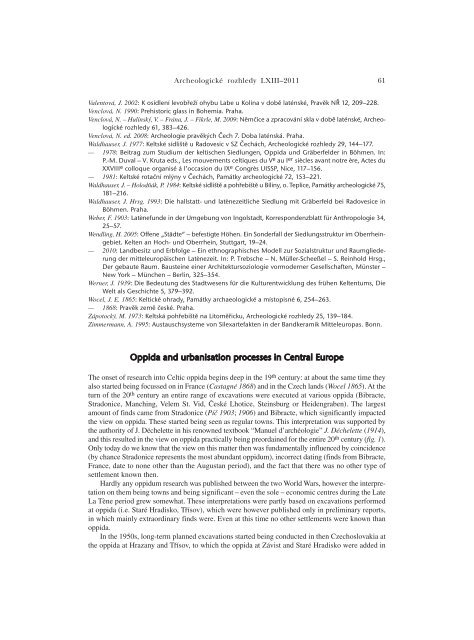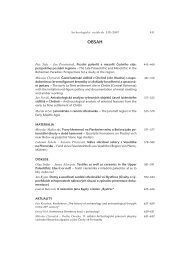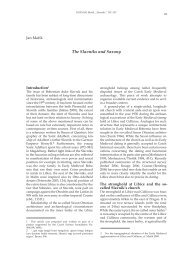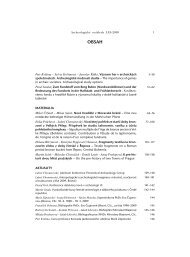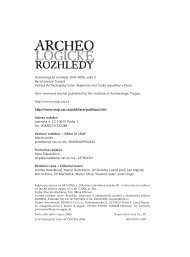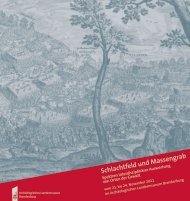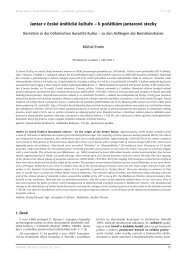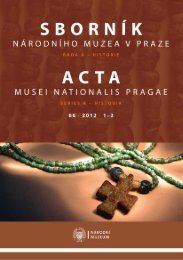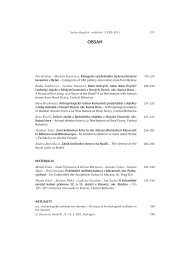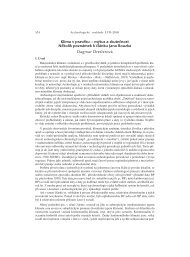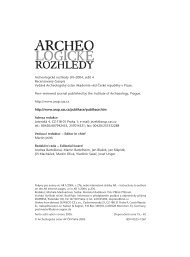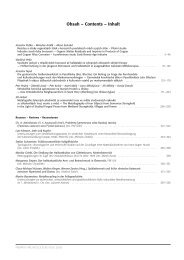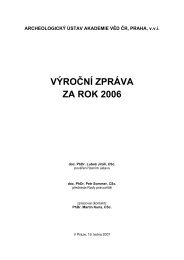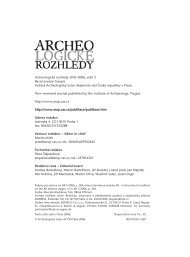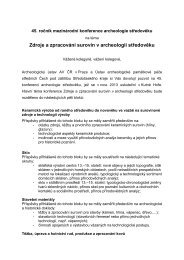Archeologické rozhledy 2011 - Archeologický ústav AV ČR
Archeologické rozhledy 2011 - Archeologický ústav AV ČR
Archeologické rozhledy 2011 - Archeologický ústav AV ČR
- No tags were found...
You also want an ePaper? Increase the reach of your titles
YUMPU automatically turns print PDFs into web optimized ePapers that Google loves.
<strong>Archeologické</strong> <strong>rozhledy</strong> LXIII–<strong>2011</strong> 61Valentová, J. 2002: K osídlení levobřeží ohybu Labe u Kolína v době laténské, Pravěk NŘ 12, 209–228.Venclová, N. 1990: Prehistoric glass in Bohemia. Praha.Venclová, N. – Hulínský, V. – Frána, J. – Fikrle, M. 2009: Němčice a zpracování skla v době laténské, <strong>Archeologické</strong><strong>rozhledy</strong> 61, 383–426.Venclová, N. ed. 2008: Archeologie pravěkých Čech 7. Doba laténská. Praha.Waldhauser, J. 1977: Keltské sídliště u Radovesic v SZ Čechách, <strong>Archeologické</strong> <strong>rozhledy</strong> 29, 144–177.— 1978: Beitrag zum Studium der keltischen Siedlungen, Oppida und Gräberfelder in Böhmen. In:P.-M. Duval – V. Kruta eds., Les mouvements celtiques du V e au I er siècles avant notre ère, Actes duXXVIII e colloque organisé á l’occasion du IX e Congrès UISSP, Nice, 117–156.— 1981: Keltské rotační mlýny v Čechách, Památky archeologické 72, 153–221.Waldhauser, J. – Holodňák, P. 1984: Keltské sídliště a pohřebiště u Bíliny, o. Teplice, Památky archeologické 75,181–216.Waldhauser, J. Hrsg. 1993: Die hallstatt- und latènezeitliche Siedlung mit Gräberfeld bei Radovesice inBöhmen. Praha.Weber, F. 1903: Latènefunde in der Umgebung von Ingolstadt, Korrespondenzblatt für Anthropologie 34,25–57.Wendling, H. 2005: Offene „Städte“ – befestigte Höhen. Ein Sonderfall der Siedlungsstruktur im Oberrheingebiet.Kelten an Hoch- und Oberrhein, Stuttgart, 19–24.— 2010: Landbesitz und Erbfolge – Ein ethnographisches Modell zur Sozialstruktur und Raumgliederungder mitteleuropäischen Latènezeit. In: P. Trebsche – N. Müller-Scheeßel – S. Reinhold Hrsg.,Der gebaute Raum. Bausteine einer Architektursoziologie vormoderner Gesellschaften, Münster –New York – München – Berlin, 325–354.Werner, J. 1939: Die Bedeutung des Stadtwesens für die Kulturentwicklung des frühen Keltentums, DieWelt als Geschichte 5, 379–392.Wocel, J. E. 1865: Keltické ohrady, Památky archaeologické a místopisné 6, 254–263.— 1868: Pravěk země české. Praha.Zápotocký, M. 1973: Keltská pohřebiště na Litoměřicku, <strong>Archeologické</strong> <strong>rozhledy</strong> 25, 139–184.Zimmermann, A. 1995: Austauschsysteme von Silexartefakten in der Bandkeramik Mitteleuropas. Bonn.Oppida and urbanisation processes in Central EuropeThe onset of research into Celtic oppida begins deep in the 19 th century: at about the same time theyalso started being focussed on in France (Castagné 1868) and in the Czech lands (Wocel 1865). At theturn of the 20 th century an entire range of excavations were executed at various oppida (Bibracte,Stradonice, Manching, Velem St. Vid, České Lhotice, Steinsburg or Heidengraben). The largestamount of finds came from Stradonice (Píč 1903; 1906) and Bibracte, which significantly impactedthe view on oppida. These started being seen as regular towns. This interpretation was supported bythe authority of J. Déchelette in his renowned textbook “Manuel d’archéologie” J. Déchelette (1914),and this resulted in the view on oppida practically being preordained for the entire 20 th century (fig. 1).Only today do we know that the view on this matter then was fundamentally influenced by coincidence(by chance Stradonice represents the most abundant oppidum), incorrect dating (finds from Bibracte,France, date to none other than the Augustan period), and the fact that there was no other type ofsettlement known then.Hardly any oppidum research was published between the two World Wars, however the interpretationon them being towns and being significant – even the sole – economic centres during the LateLa Tène period grew somewhat. These interpretations were partly based on excavations performedat oppida (i.e. Staré Hradisko, Třísov), which were however published only in preliminary reports,in which mainly extraordinary finds were. Even at this time no other settlements were known thanoppida.In the 1950s, long-term planned excavations started being conducted in then Czechoslovakia atthe oppida at Hrazany and Třísov, to which the oppida at Závist and Staré Hradisko were added in


